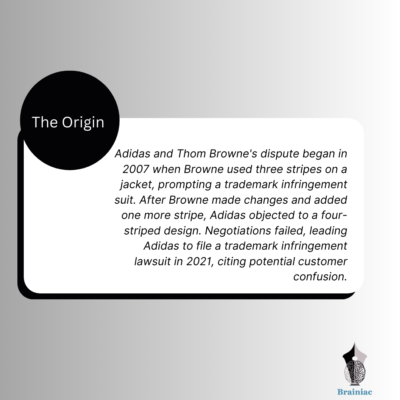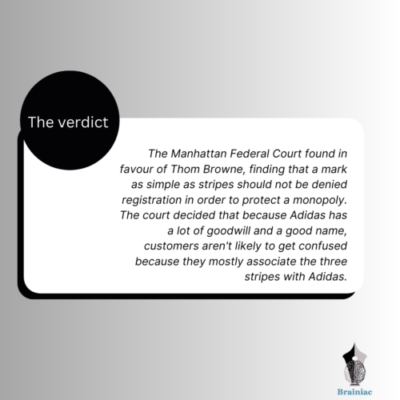Trademark law recently witnessed an intriguing issue involving sportswear giant Adidas and renowned designer Thom Browne. The case centered on the usage of stripes, with Adidas claiming that Browne’s Four-Stripe design infringed on its Three-Striped Mark. The Manhattan Federal Court found in favour of Browne in a landmark case, causing major debate in the media and the trademark community. This article digs into the case’s specifics, delving into the arguments advanced by both parties and analyzing the ramifications of the court’s ruling.
The Origin of the Conflict
 The dispute between Adidas and Thom Browne can be traced back to 2007, when Browne made a jacket with three stripes, which prompt Adidas to file a for a trademark infringement suit. Browne later made changes and added one more stripe to his trademark to deal with the problem. But things got worse again when Adidas saw Browne’s four-striped design. Adidas tried to negotiate with Browne, but they were not successful. Later, in 2021 Adidas filed a trademark infringement lawsuit against Browne. The company said that Browne’s Four-Stripe design could trick and confuse customers and was a threat to Adidas’ Three-Stripe Mark, which has been a symbol of the brand since 1952.
The dispute between Adidas and Thom Browne can be traced back to 2007, when Browne made a jacket with three stripes, which prompt Adidas to file a for a trademark infringement suit. Browne later made changes and added one more stripe to his trademark to deal with the problem. But things got worse again when Adidas saw Browne’s four-striped design. Adidas tried to negotiate with Browne, but they were not successful. Later, in 2021 Adidas filed a trademark infringement lawsuit against Browne. The company said that Browne’s Four-Stripe design could trick and confuse customers and was a threat to Adidas’ Three-Stripe Mark, which has been a symbol of the brand since 1952.
The legal Battle
Adidas tried to stop Browne’s Four-Stripe design from being registered as a federal trademark by using its good name and many federal trademarks. The company said that the design was very similar to its own Three-Stripe Mark, which could cause customers to be confused. Thom Browne, on the other hand, set up his business as a high-end fashion name for a specific type of customer. He talked about how much more expensive his goods were than Adidas’ and said that people wouldn’t mistake his Four-Stripe design for the famous Three-Stripe Mark. Browne also said that stripes are used by a lot of different brands, so it’s not fair for Adidas to say that they own such a popular idea.
The Court’s verdict
 The Manhattan Federal Court found in favour of Thom Browne, finding that a mark as simple as stripes should not be denied registration in order to protect a monopoly. The court decided that because Adidas has a lot of goodwill and a good name, customers aren’t likely to get confused because they mostly associate the three stripes with Adidas. This choice is in line with the idea of fair competition and recognizes how important it is to make sure that new players have a place in the market. By letting trademarks have generic similarities, the court supports competition law and makes sure that copyright protection doesn’t make it harder to get into a market or come up with new ideas.
The Manhattan Federal Court found in favour of Thom Browne, finding that a mark as simple as stripes should not be denied registration in order to protect a monopoly. The court decided that because Adidas has a lot of goodwill and a good name, customers aren’t likely to get confused because they mostly associate the three stripes with Adidas. This choice is in line with the idea of fair competition and recognizes how important it is to make sure that new players have a place in the market. By letting trademarks have generic similarities, the court supports competition law and makes sure that copyright protection doesn’t make it harder to get into a market or come up with new ideas.
Expert Perspectives and Controversies
Even though the court ruled in favour of Thom Browne, some experts on intellectual property say that Adidas, with its huge reputation, needs stronger protection because it has so much to lose. They say that Browne may have used Adidas’ good name in a way that wasn’t fair. Based on how well-known brands like Adidas are, these experts say that companies should have stronger trademark rights. But it is very important for the courts to stick to the basic rules of trademark law, which favour fair competition and try to stop cartels. Giving exclusive control over simple things like stripes could kill creativity and make it harder for new players to get into the market.
Conclusion
The trademark fight between Adidas and Thom Browne shows how brands, fair competition, and the limits of trademark protection all work together in a complicated way. Even though Adidas lost the case, the court’s ruling shows how important it is to keep a trademark landscape that are fair and keeps monopolies from happening. This precedent-setting ruling shows how important it is to stick to the rules of fair competition and give everyone in the market an equal chance.


 The dispute between Adidas and Thom Browne can be traced back to 2007, when Browne made a jacket with three stripes, which prompt Adidas to file a for a trademark infringement suit. Browne later made changes and added one more stripe to his trademark to deal with the problem. But things got worse again when Adidas saw Browne’s four-striped design. Adidas tried to negotiate with Browne, but they were not successful. Later, in 2021 Adidas filed a trademark infringement lawsuit against Browne. The company said that Browne’s Four-Stripe design could trick and confuse customers and was a threat to Adidas’ Three-Stripe Mark, which has been a symbol of the brand since 1952.
The dispute between Adidas and Thom Browne can be traced back to 2007, when Browne made a jacket with three stripes, which prompt Adidas to file a for a trademark infringement suit. Browne later made changes and added one more stripe to his trademark to deal with the problem. But things got worse again when Adidas saw Browne’s four-striped design. Adidas tried to negotiate with Browne, but they were not successful. Later, in 2021 Adidas filed a trademark infringement lawsuit against Browne. The company said that Browne’s Four-Stripe design could trick and confuse customers and was a threat to Adidas’ Three-Stripe Mark, which has been a symbol of the brand since 1952.
